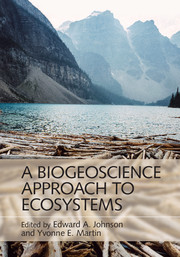Book contents
- Frontmatter
- Contents
- List of contributors
- Preface
- Miscellaneous Frontmatter
- 1 Introduction
- Part I Connecting Ecosystem and Geoscience Processes
- Part II Transport Processes and Conservation Budgets in Biogeoscience
- 3 Heat Balances in Ecological Contexts
- 4 Water Budgets in Ecosystems
- Part III Coupling Hillslope Geomorphology, Soils, Hydrology, and Ecosystems
- Part IV Coupling Fluvial and Aeolian Geomorphology, Hydrology/Hydraulics, and Ecosystems
- Index
- References
3 - Heat Balances in Ecological Contexts
from Part II - Transport Processes and Conservation Budgets in Biogeoscience
Published online by Cambridge University Press: 27 October 2016
- Frontmatter
- Contents
- List of contributors
- Preface
- Miscellaneous Frontmatter
- 1 Introduction
- Part I Connecting Ecosystem and Geoscience Processes
- Part II Transport Processes and Conservation Budgets in Biogeoscience
- 3 Heat Balances in Ecological Contexts
- 4 Water Budgets in Ecosystems
- Part III Coupling Hillslope Geomorphology, Soils, Hydrology, and Ecosystems
- Part IV Coupling Fluvial and Aeolian Geomorphology, Hydrology/Hydraulics, and Ecosystems
- Index
- References
Summary
Overview
All living systems at all levels of organization operate within the constraints imposed by their environments. These constraints may be, all at the same time, chemical, thermal, radiant and mechanical (physical) features that regulate transport of momentum, heat and mass. Geosciences give us a great deal of information about the external environments living systems have experienced, are experiencing and may experience in time. Geosciences provide information for reconstructing paleoclimates and provide estimates of environmental, plant and animal temperatures, composition of the atmosphere and the oceans in time, rates of seafloor spreading and continental movements, which affect carbon sequestration, and other phenomena. The geosciences also provide a great deal of information about the nature of the origin of life at all levels on the planet and the conditions of mass extinctions and recoveries that can help us anticipate the range of future possibilities for our current crises of environmental change.
What distinguishes living systems from inanimate ones is their immense linear and nonlinear interconnectivity at all levels and between levels of biological organization. Living organisms have an amazing ability to compensate for changes they experience over time and space by way of the vast multiplicity of feedbacks that allow them to adjust for change in their external physical environments and in their internal states. This chapter illustrates how understanding and successfully modeling mechanisms of heat, mass and momentum transfer between living organisms and their physical environments can connect molecules to organ systems to individuals to populations to communities and to ecosystems. The mechanisms illustrated here must also include the morphology, physiology and behavior as part of the analysis to define for modern plants and animals, and for ancient and future ones, their requirements for energetics, potential for movement across the landscape, habitats occupied, and selective forces that feed back in multiple ways to regulate their distribution, abundance, and evolutionary potential.
In the rest of the chapter we first discuss historical roots in engineering and biology. Then we give a brief overview of basic concepts and definitions, before moving on to increasingly complex applications of heat and mass balances constrained by animal morphology, physiology and behavior in biological and ecological sciences.
- Type
- Chapter
- Information
- A Biogeoscience Approach to Ecosystems , pp. 49 - 87Publisher: Cambridge University PressPrint publication year: 2016
References
- 7
- Cited by



